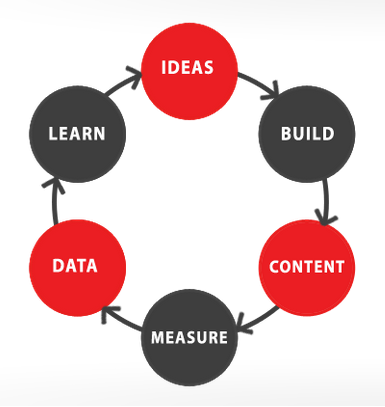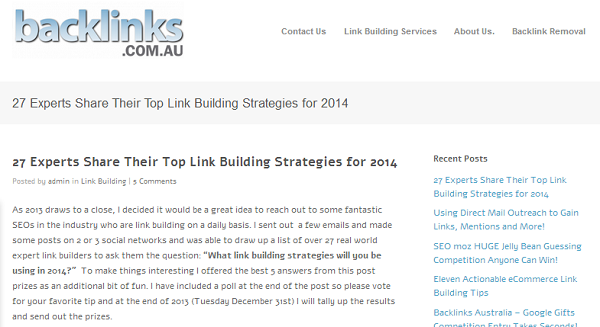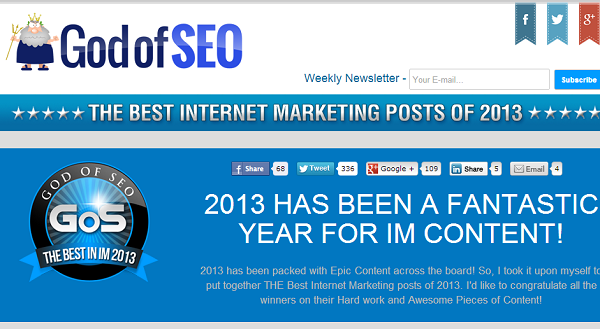by Venchito Tampon Jr | Last Updated on November 23, 2019
Scalable link building is a combination of a volume-oriented and efficient link building methodologies and strategies. The more links are being acquired through content and community-based link building tactics, the higher should be the efficiency developed in the overall campaign including the process, tools and the people working on it.
The primary idea in this approach is to focus both on the inner development and bulkiness of the activity since having more time performing a specific link building task, the higher is your chance of mastering it through constant improvement that adapts to what search engines are going after for this year and beyond.
The future of search will always emphasize the value of the business which comprises the nature of the operations, profitability and future economic benefits that should flow from different web places where customers are visible. With business’ value in mind, scaling link building efforts would result into more ROI-based results that drive authority, brand and social signals to the inner pages of the site where external sources are linking to.
Scalability in an ROI-focused link building campaign is essential for the following reasons:
- Increase in the present resources of the company (i.e. team members) can accommodate numerous demands of customers that would result into brand-related benefits (besides sales) such as positive feedbacks, brand awareness, effortless content promotion through word of mouth marketing, voluntary-given links and other secondary benefits (benefits that are not basically targeted by the campaign).
- Increase in workforce provides more time for the upper management to strategically plan the future development of the campaign (which will be more effective if priorities for different tasks are set beforehand).
- It fuels the growth of the business given that each of the team members are able to cope up with the changes/development that occur during the execution of the campaign which allows them to participate more in the strategic planning and hands-on activities.
- It standardizes the brand’s methodologies and processes for new team members. The higher the need for scalability, the more efforts should be exerted for the basic necessities of the link building team (i.e. basic manual for newbies). This will reduce the time and budget that will be needed for personal training for each team member given that manual or one general resource could help newbies to learn about every detail of the link building process (i.e. link building outreach) and go back to the section they haven’t learned and which needs repetitive learning.
For any reason, growth in link building requires scalability. The more resources (workforce, tools, etc..) are scaled for the campaign, the likelihood of continuous improvement is higher (through constructive criticisms and regular feedbacks from team members/leaders).
Without setting your team to focus on scaling certain elements in link building, growth is unlikely possible for the campaign.
The question is, in what areas should scalability be focused on?
Three Main Focus of Scalable Link Building
1. People
For obvious reasons, link building will always need people to run a campaign. With a mindset of allowing your team members to reach their maximum potentials, it would be easy for you to scale each of them (since proper training leads to scalability). Scalability in people sense is flexibility. If your people are able to work on multiple tasks, then you are effective in scaling your team.
Essentially, focusing on how you could improve the skills of your team members would greatly impact the whole campaign’s results. The more skillful your team is, the better your results will be.
Here a few tips to scale your team members:
- Think of a good list of questions that you want to ask for your applicants in the recruitment process of your team. You may either add examinations to get a feel of how knowledgeable they are in link building or offer a two-week paid test trial to see the output they can finished within that short period of time.
- Create a database that is filled with the basic resources/information that your team members must learn about as part of the team. I would suggest that you provide two tutorials:
- Video training tutorials for hands-on activities (for applications) with transcript or outline below each video.
- Text-based content (for theories)
Make it easy for your people to read each section by adding quick links at the top of the page/post.
- Let your team members send a weekly report about the results of their work, challenges they faced during the week and improvements that they can do for the team. You can add a section to your task management platform for questions and feedbacks.
Further Reading:
2. Tools
Without tools, it would be quite difficult for your team members to scale each task that you assigned to them. Tools will always play a big role in reducing the time spent for a particular activity, and ensuring that the results for every work are high quality and accustomed to the expectations set by the team.
A few tips to scale your link building tools are stated below:
- Use spreadsheet and Excel functions to speed up the process of one subset activity (i.e. finding duplicates in the list).
- Create your own tool for your in-house works to setup only one platform for all the multiple tasks you’re handling for each campaign.
- Select only a few tools that your service requires you to scale. Compare two or three tools and see which one could make your work faster and easier. Do this every 6 months or 1 year (add new tools that are publicly offered by other SEO agencies for comparison). Remember not to spend almost half of your budget for paid tools since you can also scale activities with selected free SEO tools.
- Ensure the privacy of access to each of your tools (restrict ex-members from any methods to login in any of your regular tools).
- If you’ve built a strong readership and personal branding, try contributing to product websites that offer regular content contribution on their blog sections. I’ve seen many of them offer paid subscriptions to their products in exchange for regular write-ups (monthly/weekly). By doing this, the cost assigned for tools would reduce dramatically given that you’re almost free of charge to some paid products.
3. Process
Scalable link building will not be completely performed without a process. Systems or processes will only work well if they are continuously being tested by adding some changes to them to see some improvements in the results.
Process is hard to scale since it requires testing/updates before seeing big results. Conducting multiple testings would need much higher budget and more time for the team to quickly adjust to any immediate changes that will happen during the testing period.
However, there are a few ways to make it much easier for the team members to grasp each detail of the process without making them overwhelmed with the big picture of it.
- Conduct an initial meeting with your team members for you to explain to them each activity that your team needs to perform to satisfy your clients’ needs.
- Illustrate your link building process by adding visuals/diagrams that describe how the system works.
- List down the time needed for each task to be completed. Make sure that you consider the completion time for each task when you assigned all the tasks to your team members (i.e. 15 hours to find 180-200 qualified link prospects). This will help you identify who are performing at the above par or below par output and which of them are qualified for regularization.
- Take note of frequently asked questions from your team members. Analyze which part of the link building process is difficult to understand and create a detailed video explaining that particular task.
- Perform a monthly evaluation of the team’s output by simply listing down tasks that are quickly completed by the team and activities that need more members to work on.
- Involve your team members for monthly feedbacks and consider their suggestions/feedbacks for future updates to your link building process.
- Compute your client acquisition/retention output such as:
- Retention rate (how many clients are still getting your service?)
- Client acquisition rate (how many client inquiries do you receive in a monthly basis?)
- Top assisted conversions (which websites bring you the most number of potential clients?)
There are a lot more tips that I will share on my future posts about client acquisition, task management and other process-based activities. But for now, the above tips are the most vital applications of the overall link building process.
People, tools and process are the fundamental things you have to focus on scaling your link building campaigns since these three core elements would greatly impact your business’ growth and branding.
What to Scale in Link building for 2014 and Beyond?
Content Assets
Understanding how to extract the most value out of the existing and future content assets is a must to consider for next year’s content marketing. Creating high quality content assets is not enough. You have to determine the future economic benefits of your content and how you can amplify the reach of each of your content piece.
Here are a few tips to scale your content:
- Focus on content optimization. Ensure that your asset has the essential characteristics of a high quality content:
- Comprehensiveness. The ability of the content to be mostly cited by media outlets and industry-related publications because it provides data/information that is credible and useful to different groups of audience.
- Shareable. Social sharing buttons are visible both on the above and below the fold of the page (or is static in one area). In addition, the content should be capable of multiplying its shares by having influencers mentioned in the post (either their insights are included or their content are being referenced for additional resources).
- Design. First impression lasts in content marketing. In most cases, people shared the content once they are attracted with how text/images/videos are formatted within and on the page.
- Use your content to leverage business relationships. Connect with influencers who’ve shared/linked to your content. Mentioned their content on your posts (especially posts that linked to your content) to put yourself to their radars and circles.
- Instead of doing one-time guest post, pitch authoritative blogs/news sites for regular content distribution. This would help you increase your branding, authority and your content’s ability to reach a wider group of audience (especially if you linked your best posts from your content distribution posts – i.e. guest posts).
- Invest in content development. Update existing content assets to adapt to its target industry’s environment.
- Repurpose your content to different content formats (i.e. slide presentation, ebook, etc..) to increase its likelihood of being seen by top industry curators who might linked to your other content formats.
- List down all existing linkable content assets in a spreadsheet (content inventory). Identify which of them had received a significant amount of links (by looking at the page’s number of referring domains) and shares (use Topsy). Schedule one week for linker outreach to promote existing content assets that have potential for active and passive link acquisition.
Link Acquisition
Link acquisition is a tedious activity that demands proper execution and analysis to dramatically increase the number of links acquired, penetrate influencers’ radars and build relationships with the target audience and comprehend the behavior of customers in the industry.
Scaling link acquisition would basically dig into one activity: careful qualification of link prospects. Here are two types of link qualifiers that would extract only high quality link prospects from the list.
- Automated link qualifiers such as:
- Ad placements
- Pagerank of URL
- Pagerank of domain
- Domain Authority of the site
- Page Authority
- Keywords placed on the most important areas of the page
Manual link prospecting using the above link qualifiers could possibly create a list of 50+ link prospects in an hour with the help of tools like bulk PR checker, Mozbar, Scrape Similar and a little common sense to identify the site’s ads marketing (whether or not the website is designed to provide value to the community or just earn passive income).
- Manual link qualifiers such as:
- Relevancy of the target page/site to the produced content or the client’s website itself.
- Obtainability or link acquisition level based on the relationship status of the link prospector/client to the link target.
- Competitor identification. Determining whether or not the link target is a competitor.
- Content/page has a good context in terms of grammar and spelling.
- Is the link placed on the link target’s page automated or human-generated?
- Quality of blog comments
- Accessibility of the webmaster (is the site owner’s email or contact form visible on the page?)
With these two types of link qualifiers, you can now scale the link prospecting efforts of your team by allowing them to focus on the important factors that make links good quality.
Other scalable link prospecting tips:
- Provide regular feedbacks to link prospectors (explain why link prospects are approved and others are not).
- Use tools for massive link prospecting like Ontolo and Scrape Similar and store the results in a link prospecting sheet.
- Categorize unapproved link prospects based on their link opportunities. Execute other link building efforts using those unapproved list of prospects (i.e. posting articles to industry-related forums). Approval of link prospects is based on the type of link building that the team is working on: “Approved” for resource/links page; “Not Approved” for forum links.
Outreach
Outreach efforts are scaled through evaluating these activities and results:
- Email templates that work best in getting higher response and link acquisition rates.
- Feedbacks received from link targets and their behavior towards your outreach.
- Setting an expected response rate and/or link acquisition rate for every outreach efforts (based on the industry’s environment and response to link building outreach). This would help you determine if your effort is at sub-par or above the average standard.
Here are a few initiatives that can improve the scalability of your outreach:
- Use interns for small outreach tasks like uploading CSV files (spreadsheet of contact names and emails) to outreach management tools like Buzzstream.
- If you’re only using Gmail and other free email marketing solutions, you would want to let your interns work on editing the email message (replacing the [Name of Site Owner] and [URL] with the actual contact names and websites of the link targets). This way, you would just have to check all the drafts and make it more personalized by adding introductory paragraphs to the template.
- Contact webmasters who had linked to your competitor’s content. Try a second blow of emails that is more personalized than the outreach template you’ve used on your initial contact.
Branding
The future of link building will always be on the branding and other marketing objectives of online businesses. Targeting conversions, increasing brand awareness and establishing influence and authority are a few marketing-centric goals that can send brand and social signals to the pursued website/content.
The following initiatives are best to scale your site’s branding activity:
- Take advantage of the top curators in your industry by starting to build a rapport with them and get updates for their planned interviews/round-ups. Provide your best insight/tip/strategy/tactic to the curator to get high quality backlinks over time given that the post is more likely to attract more link love from top media outlets in the industry (especially if the crowdsourced content was able to rank for a target keyword).
- Consistently create persona-based content to win top awards in your industry. This could amplify the reach of your awarded content and increase the likelihood of getting direct traffic visits.
- Participate in industry-related communities like blogs and forums by providing high-valued answers to the most commonly-asked questions.
- Start engaging with people who mentioned your brand/product/service on various web places. Regular brand mention monitoring could give you links when you asked those potential linkers politely via email or social tools.
Scalable link building is both improving the efficiency and effectiveness of your link building campaigns and understanding how to improve the value of your link building results.
To end this post, I want to thank James Norquay for giving me an awesome gift (15 GB USB with a bottle opener on its other side).
If you liked this post, kindly share it to your circles/networks and follow me on twitter @venchito14.
Merry Christmas to all of you guys!
The Author
Venchito Tampon Jr
Venchito Tampon is a Filipino Motivational Speaker, Corporate Trainer, and a Leadership Speaker in the Philippines. He is the CEO and Co-Founder of SharpRocket, a link building agency. With a decade of experience, Venchito has a proven track record of leading hundreds of successful SEO (link builidng) campaigns across competitive industries like finance, B2B, legal, and SaaS. His expert advice as a link building expert has been featured in renowned publications such as Semrush, Ahrefs, Huffington Post and Forbes. He is also an international SEO spoken and has delivered talks in SEO Zraz, Asia Pacific Affiliate Summit in Singapore, and Search Marketing Summit in Sydney, Australia. Check out his other businesses, Hills & Valleys Cafe, Blend N Sips and Saas Pursuit.
How our LINK BUILDING AGENCY builds 250 links/mo consistently using Predictable Link Building Methodology™…
- Using a SIMPLE and PROVEN system
- Using a SCALABLE strategy
- No private blog networks
- No creepy outreach emails




